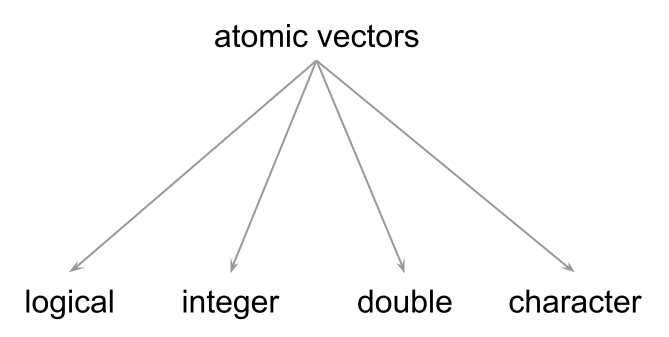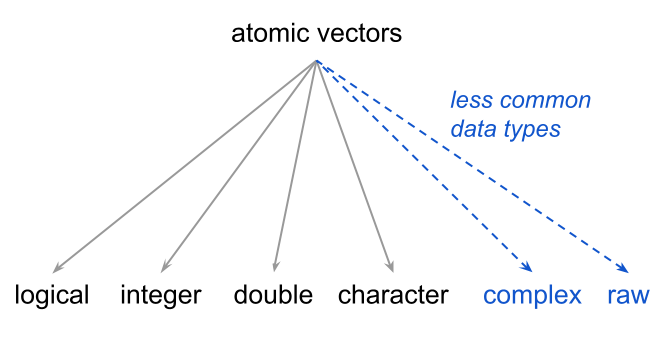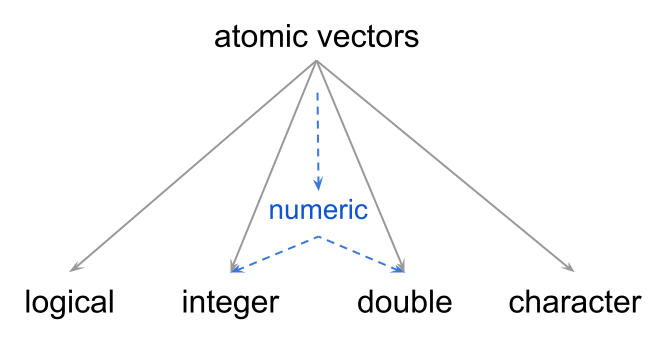2 Properties of Vectors
Vectors are the most basic kind of data objects in R. Pretty much all other R data objects are derived (or are built) from vectors. This is the reason why I like to say that, to a large extent, R is a vector-based programming language.
Based on my own experience, becoming proficient in R requires a solid understanding of the properties and behavior of R vectors.
2.1 Motivation
In the preceding chapter we ended up creating six main objects, which I’m bringing back for you in the following code chunk:
# inputs
deposit = 1000
rate = 0.02
# amounts at the end of years 1, 2, and 3
amount1 = deposit * (1 + rate)
amount2 = amount1 * (1 + rate)
amount3 = amount2 * (1 + rate)
# combine in a single object
amounts = c(amount1, amount2, amount3)
amounts
> [1] 1020.000 1040.400 1061.208As we said, all these objects are vectors.
To give you a mental picture of what a vector could like, you can think of a vector as set of contiguous “cells” of data, like in the diagram below:

Figure 2.1: Think of vectors as contiguous cells of data.
Because this is supposed to be a “mental representation” of a vector, you can think of a vector either horizontally or vertically oriented. It does not really matter which orientation you prefer to visualize since R has no notion of a vector’s orientation.
Regardless of how you decide to picture a vector in your head, an important trait of this class of object, and of any other data object in R, is that the starting position or index is always number 1.
2.2 Vectors are Atomic Objects
The first thing you should learn about R vectors is that they are considered to be atomic structures, which is just the fancy name to indicate that all the elements in a vector are of the same type.
R has four main basic types of atomic vectors:
logicalintegerdoubleorrealcharacter
Here are simple examples of the four common data types of vectors:
# logical
a = TRUE
# integer
x = 1L
# double (real)
y = 5
# character
b = "yosemite"Logical values, known as boolean values in other languages, are TRUE and
FALSE. These values can be abbreviated by using their first letters T and
F, although I discourage you from doing this because it can make code review
a bit harder. Also, notice that these logical values are specified with upper
case letters. Recall that R is case sensitive, so if you type True or False
R will not recognize them as logical values.
Integer values have an awkward syntax. Notice the appended L when assigning
number 1 to object x. This is not a typo. Rather, this is the syntax used in
R to indicate that a number (with no decimals) is an integer.
If you just simply type a number like 1 or 5, even though cosmetically
they correspond to the mathematical notion of integer numbers, R stores those
numbers as double type. So if you want to declare those numbers as type
integer, you should append an upper case letter L to encode them as 1L
and 5L.
Character types, referred to as strings in other languages, are specified by
surrounding characters within quotes: either double quotes "yosemite" or
single quotes 'yosemite'. The important thing is to have an opening and a
closing quote of the same kind.
The following diagram summarizes the four common data types of vectors.

Figure 2.2: Common data types of atomic vectors.
2.2.1 Complex and Raw Types
There are two additional types that are less commonly used: complex
(for complex numbers), and raw (raw bytes) which is a binary format used by R.

Figure 2.3: The 4 most common, and 2 less common, data types of atomic vectors.
I got my first contact with R back in 2001, and I’ve been using it almost on a
daily basis since 2005. I have never had the need to use raw vectors; R may
be using them in the background but not me (at least not explicitly or
consciously). As for complex numbers, I’ve seen them every once in a while
when doing certain matrix algebra computations. But again, I haven’t
had the need to intentionally work with complex values. I can say the same thing
about most of my colleagues: they rarely use these data types. And I’m willing
to bet that you will rarely use them too. But now you know, if you ever need
to work with complex and/or raw values, they are available in R.
2.3 Types and Modes
How do you know that a given vector is of a certain data type? For better or worse, there is a couple of functions that allow you to answer this question:
typeof()storage.mode()mode()
Although not commonly used within the R community, my recommended function
to determine the data type of a vector is typeof(). The reason for this
recommendation is because typeof() returns the data types previously listed
which are what most other programming languages use:
typeof(deposit)
> [1] "double"
typeof(rate)
> [1] "double"You should know that among the R community, many useRs don’t really talk about
types. Instead, because of historical reasons related to the S language—on
which R is based—you will often hear useRs talking about modes. To further
complicate matters, there is not just one but two functions related to the
concept of mode: storage.mode() and mode().
storage.mode(deposit)
> [1] "double"
mode(deposit)
> [1] "numeric"Both storage.mode() and mode() rely on the output of typeof(), and as
their name indicate, provide information about the storage mode. So what is
the difference between these functions?
For practical purposes, storage.mode() is similar to typeof(), in the
sense that they both return the same output:
typeof(deposit)
> [1] "double"
storage.mode(deposit)
> [1] "double"In turn, mode() behaves a bit different. mode() groups together types
"double" and "integer" into a single mode called "numeric" because both
data types are numeric values.
typeof(deposit)
> [1] "double"
mode(deposit)
> [1] "numeric"The following diagram depicts the numeric mode of types integer and
double:

Figure 2.4: Data types “integer” and “double” correspond to “numeric” mode.
R also comes with a set of testing functions to determine the type and mode of a given value:
is.logical()to test if a value is of type logicalis.integer()to test if a value is of type integeris.double()to test if a value is of type doubleis.numeric()to test if a value is of numeric mode: either integer or doubleis.character()to test if a value is of type character
We discuss more details about how R handles data types in chapter More About Vectors. In the meantime, the following table shows basic examples of each common data type, and the output of associated functions that give you information about the type and mode of vectors:
| Example | typeof() |
storage.mode() |
mode() |
|---|---|---|---|
TRUE |
"logical" |
"logical" |
"logical" |
1L |
"integer" |
"integer" |
"numeric" |
1 |
"double" |
"double" |
"numeric" |
"one" |
"character" |
"character" |
"character" |
2.4 Special Values
In addition to the four common data types, R also comes with a series of special values:
NULLis the null object (it has length zero). The way I like to think of this is as “nothing”; that is, an object that represents “nothing”.NA, which stands for Not Available, indicates a missing value. By default, typingNAis stored as a logical value. But there are also special types of missing values.NA_integer_NA_real_NA_character_
NaNindicates Not a Number. An example of this value is the output returned by computing the square root of a negative number:sqrt(-5)Infindicates positive infinite, e.g.100/0-Infindicates negative infinite, e.g.-100/0
R also comes with a set of testing functions to determine if a given value is of a special kind:
is.null()to test if a value isNULLis.na()to test if a value isNAis.nan()to test if a value isNaNis.infinite()to test if a value isInfor-Inf
2.5 Length of Vectors
Another important property about vectors is that they have length, which refers to the number of elements or cells that they contain. If it helps, you can think of length as the “size” of a vector.
The simplest kind of vectors are single values—i.e. vectors with just one
element. For example, objects such as deposit and rate are one-element
vectors. To find the length of a vector you use the function length()
length(deposit)
> [1] 1
length(amounts)
> [1] 3By the way, vectors can be of any length, including 0. We talk more about these special vectors in the next chapter.
No Scalars in R
In most other languages, a number like 5 or a logical TRUE are usually
considered to be “scalars”. R, however, does not have the concept of “scalar”,
instead the simplest data structure is that of a one-element vector. This means
that when you type 5 R handles this data with a vector of length one.
2.6 Vector elements can have names
Another feature of vectors is that their elements can have names. For example,
we have the amounts vector that contains the savings amounts at the end of
years 1, 2, and 3:
amounts
> [1] 1020.000 1040.400 1061.208We can give names to the elements in amounts by using the names() function.
We apply names() to amounts and we assign a vector of names like so:
names(amounts) = c("year1", "year2", "year3")
amounts
> year1 year2 year3
> 1020.000 1040.400 1061.2082.7 Exercises
Consider the following three types of financial products:
joint savings account that pays 2% annual return, during 2 years,
joint money market account that pays 3% annual return, during 3 years
individual certificate of deposit that pays 4% annual return, during 4 years
Questions below.
1) Use the c() function to create a character vector accounts such
that when printed it displays the values shown below:
> [1] "savings" "money market" "certificate"2) Use the c() function to create a vector joint of logical values
such that when printed it displays the values shown below:
> [1] TRUE TRUE FALSE3) Use the c() function to create a vector rates such that when
printed it displays the values shown below:
> [1] 0.02 0.03 0.044) Use the function names() to give names to the elements of your vector rates. When printing rates you should get following output:
> savings market certif
> 0.02 0.03 0.045) Use the c() function to create a vector years of integer
values such that when printed it displays the values shown below. Recall
that integer values are of the form 1L.
> [1] 2 3 46) Use the typeof() function to inspect the data type of accounts,
joint, rates, and years. Confirm that their output is "character",
"logical", "double" and "integer", respectively.
7) Use the length() function to inspect the length of accounts,
joint, rates, and years.
8) Explain, in your own words, why vectors are said to be atomic objects.
9) Explain, in your own words, the difference between the output of
functions typeof() and mode()—when applied to vectors.